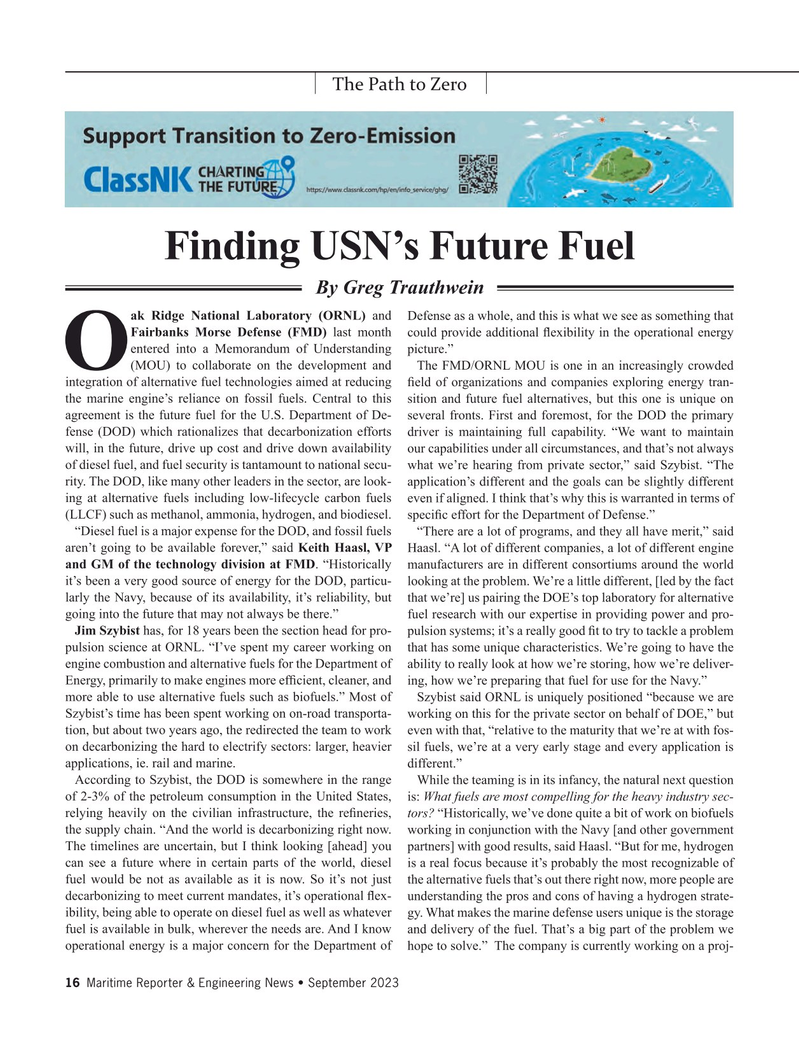
Page 16: of Maritime Reporter Magazine (September 2023)
Marine Design Edition
Read this page in Pdf, Flash or Html5 edition of September 2023 Maritime Reporter Magazine
The Path to Zero
Finding USN’s Future Fuel
By Greg Trauthwein ak Ridge National Laboratory (ORNL) and Defense as a whole, and this is what we see as something that
Fairbanks Morse Defense (FMD) last month could provide additional ? exibility in the operational energy entered into a Memorandum of Understanding picture.”
O(MOU) to collaborate on the development and The FMD/ORNL MOU is one in an increasingly crowded integration of alternative fuel technologies aimed at reducing ? eld of organizations and companies exploring energy tran- the marine engine’s reliance on fossil fuels. Central to this sition and future fuel alternatives, but this one is unique on agreement is the future fuel for the U.S. Department of De- several fronts. First and foremost, for the DOD the primary fense (DOD) which rationalizes that decarbonization efforts driver is maintaining full capability. “We want to maintain will, in the future, drive up cost and drive down availability our capabilities under all circumstances, and that’s not always of diesel fuel, and fuel security is tantamount to national secu- what we’re hearing from private sector,” said Szybist. “The rity. The DOD, like many other leaders in the sector, are look- application’s different and the goals can be slightly different ing at alternative fuels including low-lifecycle carbon fuels even if aligned. I think that’s why this is warranted in terms of (LLCF) such as methanol, ammonia, hydrogen, and biodiesel. speci? c effort for the Department of Defense.” “Diesel fuel is a major expense for the DOD, and fossil fuels “There are a lot of programs, and they all have merit,” said aren’t going to be available forever,” said Keith Haasl, VP Haasl. “A lot of different companies, a lot of different engine and GM of the technology division at FMD. “Historically manufacturers are in different consortiums around the world it’s been a very good source of energy for the DOD, particu- looking at the problem. We’re a little different, [led by the fact larly the Navy, because of its availability, it’s reliability, but that we’re] us pairing the DOE’s top laboratory for alternative going into the future that may not always be there.” fuel research with our expertise in providing power and pro-
Jim Szybist has, for 18 years been the section head for pro- pulsion systems; it’s a really good ? t to try to tackle a problem pulsion science at ORNL. “I’ve spent my career working on that has some unique characteristics. We’re going to have the engine combustion and alternative fuels for the Department of ability to really look at how we’re storing, how we’re deliver-
Energy, primarily to make engines more ef? cient, cleaner, and ing, how we’re preparing that fuel for use for the Navy.” more able to use alternative fuels such as biofuels.” Most of Szybist said ORNL is uniquely positioned “because we are
Szybist’s time has been spent working on on-road transporta- working on this for the private sector on behalf of DOE,” but tion, but about two years ago, the redirected the team to work even with that, “relative to the maturity that we’re at with fos- on decarbonizing the hard to electrify sectors: larger, heavier sil fuels, we’re at a very early stage and every application is applications, ie. rail and marine. different.”
According to Szybist, the DOD is somewhere in the range While the teaming is in its infancy, the natural next question of 2-3% of the petroleum consumption in the United States, is: What fuels are most compelling for the heavy industry sec- relying heavily on the civilian infrastructure, the re? neries, tors? “Historically, we’ve done quite a bit of work on biofuels the supply chain. “And the world is decarbonizing right now. working in conjunction with the Navy [and other government
The timelines are uncertain, but I think looking [ahead] you partners] with good results, said Haasl. “But for me, hydrogen can see a future where in certain parts of the world, diesel is a real focus because it’s probably the most recognizable of fuel would be not as available as it is now. So it’s not just the alternative fuels that’s out there right now, more people are decarbonizing to meet current mandates, it’s operational ? ex- understanding the pros and cons of having a hydrogen strate- ibility, being able to operate on diesel fuel as well as whatever gy. What makes the marine defense users unique is the storage fuel is available in bulk, wherever the needs are. And I know and delivery of the fuel. That’s a big part of the problem we operational energy is a major concern for the Department of hope to solve.” The company is currently working on a proj- 16 Maritime Reporter & Engineering News • September 2023
MR #9 (1-17).indd 16 9/6/2023 5:40:22 PM

 15
15

 17
17
